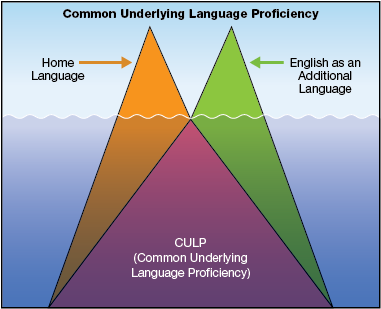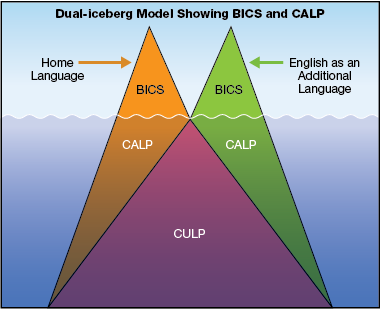Understanding the Acquisition of English as an Additional Language
Developing a Common Language BaseAccording to language experts, the thousands of different languages in the world share certain fundamental rules and principles. Many experts also believe that people are born with an innate predisposition for understanding language structures, regardless of the specific languages that they are learning. This explains why, when first acquiring an additional language, children tend to recognize language structures as correct or incorrect without being taught each specific word or grammatical structure and its meaning. What Is Common Underlying Language Proficiency (CULP)?Linguists have proposed that the language knowledge and skills that students develop as they learn one language can be used to help them learn other languages. This common underlying language proficiency (CULP CULP (common underlying language proficiency) the language knowledge and skills that students develop as they learn one language that they can then use to help them learn other languages) provides a base for the development of both the first language and any additional language(s). As students expand their understanding of one language, their understanding of all the languages they are learning expands. CULP expands as students understand more about their languages; and as CULP expands, it becomes easier to learn additional languages. The following illustration of a dual-peaked iceberg shows how a student’s CULP is the foundation for the development of both the first language and the second or additional language, in this case English.  The metaphor of a dual-peaked iceberg illustrates another aspect of language acquisition. The illustration that follows shows the relationship between the development of a student’s social language (BICSBICS (basic interpersonal communicative skills): simple, functional language for communicating basic needs, ideas, and opinions and engaging in everyday conversations in informal social situations) and the development of academic language (CALPCALP (cognitive academic language proficiency): language required to understand and communicate about abstract concepts and accomplish a wide-range of cognitively demanding academic tasks, including reading textbooks, writing essays, and doing research).  Each side of this dual-peaked iceberg is divided between BICS and CALP. Language categorized as BICS is easily observed because it shows above the water’s surface, while language categorized as CALP tends to be less obvious and easily overlooked because it resides beneath the water’s surface. Yet, it is essential for students to develop CALP to achieve higher levels of language proficiency. It is also essential for English language learners to develop CALP as rapidly as possible to achieve academic success. What Is Positive and Negative Language Transfer?English language learners use what they know from their home languagehome language: the dominant language that a student uses at home to communicate with family members and apply it to their developing understanding of English. Sometimes this language transfer can be positive and sometimes it can be negative. Positive Language Transfer Positive language transfer occurs most often when the
An example of positive transfer is when students apply knowledge about cognatescognates: words in different languages sharing a common origin Negative Language Transfer Negative language transfer, or linguistic interference, occurs when students incorrectly transfer their knowledge of vocabulary, structures, and rules from their home language to their understanding and use of English. While cognates can be a part of positive language transfer, false cognates can be a part of negative language transfer. False cognates are words that may look and sound similar in two languages but have different meanings; e.g., calve means “to give birth to a calf” in English, and calvo means “to be bald” in Spanish. Noun gender is another area where negative language transfer can occur. For example, the English nouns for men, boys, and male animals are masculine nouns, and these nouns can be replaced by the pronoun he. Similarly, the English nouns for women, girls, and female animals are feminine nouns, and these nouns can be replaced by the pronoun she. Other English nouns are gender neutral (neuter) and can be replaced by the pronoun it. However, noun gender may be quite different in English compared to some other languages that have noun gender. Here’s an example of negative language transfer based on incorrectly transferring knowledge of German noun gender to English. Consider the following English sentences: The girl is sick. She has a fever. Now look at the German equivalents: Das Mädchen (neuter) ist krank. Es (it) hat Fieber. An English language learner who speaks German may say: The girl is sick. It has fever. As well, some languages have grammar rules that are significantly different from those in English. For instance, some languages have no tense markers or gender pronouns, or they may have different placement of adjectives. Although linguistic interference can occur, English language learners should be encouraged to use and continue to develop proficiency in their first or home language(s). The languages they already know will help them learn English—and any additional languages. |

